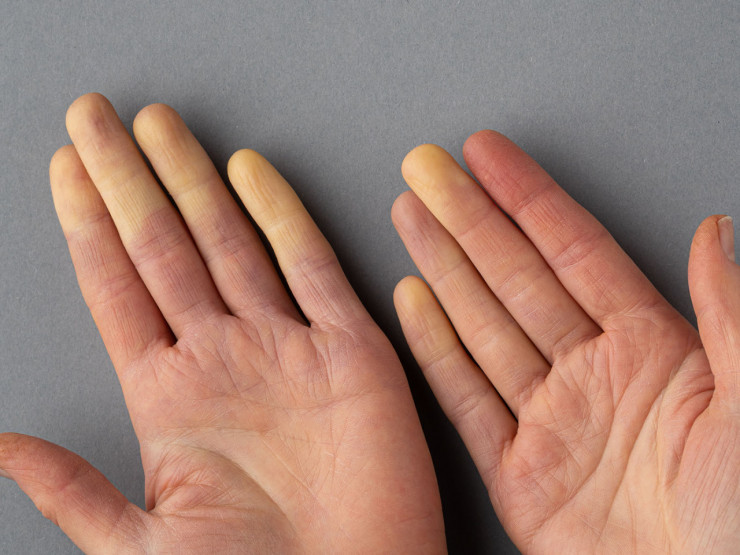If you’ve ever noticed your hands go white or blue when exposed to the cold (despite those around you feeling fine), you could have Raynaud’s.
Raynaud’s is a condition that causes your blood vessels to become hypersensitive. This causes temporary spasms of the blood vessels in your finger or your ears, toes, nipples or nose.
As the blood vessels get smaller, your fingers can also feel numb or look blue, white or even waxy in appearance and you experience discomfort or pain. This discomfort isn’t relieved immediately when the fingers or affected area warms up. Often, you’ll experience a tingling, burning or throbbing sensation as your blood vessels reopen that feels similar to ‘pins and needles’.
There are two main types of Raynaud’s. Primary Raynaud’s (also called Raynaud’s disease) doesn’t have an underlying cause and doesn’t cause significant health problems. Secondary Raynaud’s (also called Raynaud’s Syndrome or Raynaud’s Phenomenon) is caused by an underlying condition or disease and can cause serious health problems due to prolonged restriction of blood flow.
The main causes of Raynaud’s include a genetic predisposition, anxiety and stress, autoimmune diseases, vibration damage, injury or the side effects of medicine.
Although there isn’t currently a cure for Raynaud’s, there are many ways you can better manage your symptoms and reduce the frequency of attacks. This includes the following:
Quit smoking
Smoking is one of the potential causes of Raynaud’s and can trigger or worsen your symptoms. It’s never too late to stop. Speak to a member of the Whitworth team if you need extra support to quit - we offer a stop smoking service and sell many over the counter products such as nicotine replacement patches, gum and lozenges.
Get more exercise
Exercise helps boost your circulation and can help ease your symptoms. Find opportunities to move whenever you can, even if it’s very gentle exercise such as walking. Other excellent choices include swimming, yoga and Pilates.
Reduce your caffeine consumption
Caffeine can often trigger symptoms so cut back on your tea, coffee, cola, energy drink and chocolate consumption. If you want a warming drink, why not choose a delicious herbal or fruit tea instead? Ginger tea is said to be an excellent choice for Raynaud’s sufferers.
Stay warm
Make sure you keep your body warm as much as possible. If it’s cold outside, wear as many layers of warm clothes as you need to keep the heat in. Consider wearing two pairs of gloves or several pairs of socks if it’s particularly cold outside. Also avoid touching cold surfaces, cold items or spending time where the temperature fluctuates.
Eat a healthy diet
Make sure you’re eating plenty of fresh vegetables and fruit, healthy protein, healthy fats and complex carbs to keep your circulation in tip-top shape. In colder weather, stews and soups can make a big difference to your symptoms. Some sufferers suggest that eating spices like ginger, garlic, cayenne, and chilli can also help.
Learn stress-management techniques
Stress and anxiety can often trigger or worsen an attack so it’s worth learning some effective stress-management techniques that can help. Yoga, Tai Chi, meditation and breathing or relaxation exercises are said to be excellent.
Speak to your doctor
If your symptoms are severe, if they appear suddenly or if they appear in a child under 12, you should speak to your doctor. They can diagnose your Raynaud’s, look for underlying causes and potentially prescribe medication if necessary.
Summary
Raynaud’s can be an uncomfortable or even painful condition for sufferers. With the right treatment and lifestyle changes, you can reduce the frequency and severity of attacks. Follow these tips we’ve shared above and speak to your doctor if your symptoms are severe, you develop sores or if attacks only happen on one side of your body.



